A Methodology for the Prediction of Extreme Precipitation in Complex Terrains: A Case Study of Central Southwest China
Abstract
1. Introduction
2. Data and Method
2.1. Data
2.2. Method
2.2.1. Extreme Precipitation Index
2.2.2. Statistical Analysis
2.2.3. Convolutional Neural Network
2.2.4. Long Short-Term Memory
2.2.5. Loss Function
3. Results
3.1. The Spatial and Temporal Distribution of Extreme Precipitation in CSC
3.2. The Predict Model of Extreme Precipitation Frequency in Summer for the CSC
3.2.1. The Key Areas of SST Affect
3.2.2. Application in Deep Learning (CNN-LSTM Network)
4. Discussion
5. Conclusions
Author Contributions
Funding
Data Availability Statement
Conflicts of Interest
References
- IPCC. Climate Change 2022: Impacts, Adaptation, and Vulnerability. Contribution of Working Group II to the Sixth Assessment Report of the Intergovernmental Panel on Climate Change; Cambridge University Press: Cambridge, UK; New York, NY, USA, 2022; 3056p.
- Easterling, D.R.; Evans, J.L.; Groisman, P.Y.; Karl, T.R.; Kunkel, K.E.; Ambenje, P. Observed variability and trends in extreme climate events: A brief review. Bull. Am. Meteorol. Soc. 2000, 81, 417–425. [Google Scholar] [CrossRef]
- Kendon, E.J.; Roberts, N.M.; Fowler, H.J.; Roberts, M.J.; Chan, S.C.; Senior, C.A. Heavier summer downpours with climate change revealed by weather forecast resolution model. Nat. Clim. 2014, 4, 570–576. [Google Scholar] [CrossRef]
- Capello, M. Changes in the physical characteristics of the water column at the mouth of a torrent during an extreme rainfall event. J. Hydrol. 2016, 541, 146–157. [Google Scholar] [CrossRef]
- Zhang, X.; Zwiers, F.W.; Li, G.; Wan, H.; Cannon, A.J. Complexity in estimating past and future extreme short-duration rainfall. Nat. Geosci. 2017, 10, 255–259. [Google Scholar] [CrossRef]
- Cramer, S.; Kampouridis, M.; Freitas, A.A.; Alexandridis, A.K. An extensive evaluation of seven machine learning methods for rainfall prediction in weather derivatives. Expert Syst. Appl. 2017, 85, 169–181. [Google Scholar] [CrossRef]
- Di, Y.; Ding, W.; Mu, Y.; Small, D.L.; Islam, S.; Chang, N.-B. Developing machine learning tools for long-lead heavy precipitation prediction with multi-sensor data. In Proceedings of the 2015 IEEE 12th International Conference on Networking, Sensing and Control, Taipei, Taiwan, 9–11 April 2015. [Google Scholar]
- Knighton, J.; Pleiss, G.; Carter, E.; Lyon, S.; Walter, M.T.; Steinschneider, S. Potential predictability of regional precipitation and discharge extremes using synoptic-scale climate information via machine learning: An evaluation for the eastern continental United States. J. Hydrometeorol. 2019, 20, 883–900. [Google Scholar] [CrossRef]
- Molina, M.J.; Gagne, D.J.; Prein, A.F. A benchmark to test generalization capabilities of deep learning methods to classify severe convective storms in a changing climate. Earth Space Sci. 2021, 8, e2020EA001490. [Google Scholar] [CrossRef]
- Charlesworth, E.; Plöger, F.; Birner, T.; Baikhadzhaev, R.; Abalos, M.; Abraham, N.L.; Akiyoshi, H.; Bekki, S.; Dennison, F.; Jöckel, P.; et al. Stratospheric water vapor affecting atmospheric circulation. Nat. Commun. 2023, 14, 3925. [Google Scholar] [CrossRef]
- Tang, Y.; Huangfu, J.; Huang, R.; Chen, W. Surface warming reacceleration in offshore China and its interdecadal effects on the East Asia–Pacific climate. Sci. Rep. 2020, 10, 14811. [Google Scholar] [CrossRef]
- Wu, X.; Guo, S.; Yin, J.; Yang, G.; Zhong, Y.; Liu, D. On the event-based extreme precipitation across china: Time distribution patterns, trends, and return levels. J. Hydrol. 2018, 562, 305–317. [Google Scholar] [CrossRef]
- Lu, C.; Lott, F.C.; Sun, Y.; Stott, P.A.; Christidis, N. Detectable anthropogenic influence on changes in summer precipitation in China. J. Clim. 2022, 33, 5357–5369. [Google Scholar] [CrossRef]
- Sun, J.; Zhang, F.Q. Daily extreme precipitation and trends over China. Sci. China Earth Sci. 2017, 44, 1689–1701. [Google Scholar] [CrossRef]
- Guo, J.; Huang, G.; Wang, X.; Li, Y.; Yang, L. Future changes in precipitation extremes over China projected by a regional climate model ensemble. Atmos. Environ. 2018, 188, 142–156. [Google Scholar] [CrossRef]
- Xiao, C.; Wu, P.; Zhang, L.; Song, L. Robust increase in extreme summer rainfall intensity during the past four decades observed in China. Sci. Rep. 2016, 6, 38506. [Google Scholar] [CrossRef] [PubMed]
- Zhai, P.; Zhang, X.; Wan, H. Trends in total precipitation and frequency of daily precipitation extremes over China. J. Clim. 2005, 18, 1096–1108. [Google Scholar] [CrossRef]
- Lau, N.C.; Nath, M.J. A Model Investigation of the Role of Air–Sea Interaction in the Climatological Evolution and ENSO-Related Variability of the Summer Monsoon over the South China Sea and Western North Pacific. J. Clim. 2009, 22, 4771–4792. [Google Scholar] [CrossRef]
- Gu, X.; Ye, L.; Xin, Q.; Zhang, C.; Zeng, F.; Nerantzaki, S.D.; Papalexiou, S.M. Extreme Precipitation in China: A Review on Statistical Methods and Applications. Adv. Water Resour. 2022, 163, 104144. [Google Scholar] [CrossRef]
- Yu, S.; Luo, Y.; Wu, C.; Zheng, D.; Liu, X.; Xu, W. Convective and microphysical characteristics of extreme precipitation revealed by multisource observations over the pearl river delta at monsoon coast. Geophys. Res. Lett. 2022, 49, e2021GL097043. [Google Scholar] [CrossRef]
- Ding, T.; Ke, Z. A Comparison of statistical approaches for seasonal precipitation prediction in Pakistan. Weather Forecast. 2013, 28, 1116–1132. [Google Scholar] [CrossRef]
- Li, J.; Wang, B. Predictability of summer extreme precipitation days over eastern China. Clim. Dyn. 2018, 51, 4543–4554. [Google Scholar] [CrossRef]
- Han, T.; Wang, H.; Hao, X.; Li, S. Seasonal Prediction of Midsummer Extreme Precipitation Days over Northeast China. J. Appl. Meteorol. Climatol. 2019, 58, 2033–2048. [Google Scholar] [CrossRef]
- Szturc, J.; Ośródka, K.; Jurczyk, A.; Otop, I.; Linkowska, J.; Bochenek, B.; Pasierb, M. Quality control and verification of precipitation observations, estimates, and forecasts. In Precipitation Science; Michaelides, S., Ed.; Elsevier: Amsterdam, The Netherlands, 2022; Volume 3, pp. 91–133. [Google Scholar]
- Kalnay, E.; Kanamitsu, M.; Kistler, R.; Collins, W.; Deaven, D.; Gandin, L.; Iredell, M.; Saha, S.; White, G.; Woollen, J.; et al. The NCEP/NCAR 40-Year reanalysis project. Bull. Am. Meteorol. Soc. 1996, 77, 437–471. [Google Scholar] [CrossRef]
- Reynolds, R.W.; Smith, T.M.; Liu, C.; Chelton, D.B.; Casey, K.S.; Schlax, M.G. Daily high-resolution blended analyses for sea surface temperature. J. Clim. 2007, 20, 5473–5496. [Google Scholar] [CrossRef]
- Frich, P.; Alexander, L.; Dellamarta, P.; Gleason, B.; Haylock, M.; Tank, A.; Peterson, T. Observed coherent changes in climatic extremes during the second half of the twentieth centur. Clim. Res. 2002, 19, 193–212. [Google Scholar] [CrossRef]
- Farge, M. Wavelet transforms and their applications to turbulence. Annu. Rev. Fluid Mech. 1992, 24, 395–457. [Google Scholar] [CrossRef]
- Pearson, K. On lines and planes of closest fit to system of points in space. Philos. Mag. 1902, 2, 559–572. [Google Scholar] [CrossRef]
- Cui, D.X.; Liu, W.Y. Application of empirical orthogonal function resolution to analysis of crustal vertical deformation field. Earthquake 2000, 20, 82–86. [Google Scholar]
- Bretherton, C.S.; Smith, C.; Wallace, J.M. An intercomparison of methods for finding coupled patterns in climate data. J. Clim. 1992, 5, 541–560. [Google Scholar] [CrossRef]
- Wallance, J.M.; Smith, C.; Bretherton, C.S. Singular value decomposition of wintertime sea surface temperature and 500 mb height anomalies. J. Clim. 1992, 5, 561–576. [Google Scholar] [CrossRef]
- Lawrence, S.; Giles, C.L.; Tsoi, A.C.; Back, A.D.; Report, T. Face Recognition: A Hybrid Neural Network Approach. In IEEE International Multi Topic Conference; IEEE: New York, NY, USA, 1997. [Google Scholar]
- Krizhevsky, A.; Sutskever, I.; Hinton, G. Imagenet classification with deep convolutional neural networks. Adv. Neural Inf. Process. Syst. 2012, 25. [Google Scholar] [CrossRef]
- Nagi, J.; Ducatelle, F.; Caro GA, D.; Ciresan, D.; Gambardella, L.M. Max-pooling convolutional neural networks for vision-based hand gesture recognition. In Proceedings of the IEEE International Conference on Signal & Image Processing Applications, Kuala Lumpur, Malaysia, 16–18 November 2011; IEEE: New York, NY, USA. [Google Scholar]
- Wu, S.; Lew, M. Comparison of Information Loss Architectures in CNNs. In Proceedings of the 17th Pacific-Rim Conference on Multimedia, Xi’an, China, 15–16 September 2016; Springer: Cham, Switzerland, 2016. [Google Scholar]
- Salehinejad, H.; Sankar, S.; Barfett, J.; Colak, E.; Valaee, S. Recent Adv. Recurr. Neural Networks. arXiv 2017, arXiv:1801.01078. [Google Scholar]
- Hochreiter, S.; Schmidhuber, J. Long short-term memory. Neural Comput. 1997, 9, 1735–1780. [Google Scholar] [CrossRef]
- Graves, A. Sequence transduction with recurrent neural networks. Comput. Sci. 2012, 58, 235–242. [Google Scholar]
- Agga, A.; Abbou, A.; Labbadi, M.; El Houm, Y.; Ali, I.H.O. CNN-LSTM: An efficient hybrid deep learning architecture for predicting short-term photovoltaic power production. Electr. Power Syst. Res. 2022, 208, 107908. [Google Scholar] [CrossRef]
- Hodson, T. Root mean square error (RMSE) or mean absolute error (MAE): When to use them or not. Electr. Power Syst. Res. 2022, 15, 5481–5487. [Google Scholar] [CrossRef]
- Nitta, T. Unusual summer weather over Japan in 1988 and its relationship to the Tropics. J. Meteorol. Soc. Jpn. 1990, 68, 575–587. [Google Scholar] [CrossRef][Green Version]
- Yuan, Y.; Yang, S. Impacts of different types of El Niño on the East Asian climate: Focus on ENSO cycles. J. Clim. 2012, 25, 7702–7722. [Google Scholar] [CrossRef]
- Zhang, Y.; Zhou, W.; Wang, X.; Chen, S.; Chen, J.; Li, S. Indian Ocean Dipole and ENSO’s mechanistic importance in modulating the ensuing-summer precipitation over Eastern China. npj Clim. Atmos. Sci. 2022, 5, 48. [Google Scholar] [CrossRef]
- Doswell, C.A., III; Brooks, H.E.; Maddox, R.A. Flash flood forecasting: An ingredients-based methodology. Weather Forecast. 1996, 11, 560–581. [Google Scholar]
- Wang, B.; Gao, Z.; Chen, F.; Lu, C. Impact of Tibetan Plateau surfaceheating on persistent extreme precipitation events in southeastern China. Mon. Weather Rev. 2017, 145, 3485–3505. [Google Scholar]
- Xie, S.P.; Yan, D.; Gang, H. Decadal shift in El Niño influences on Indo -Western Pacificand East Asian climate in the 1970s. J. Clim. 2010, 23, 3352–3368. [Google Scholar] [CrossRef]
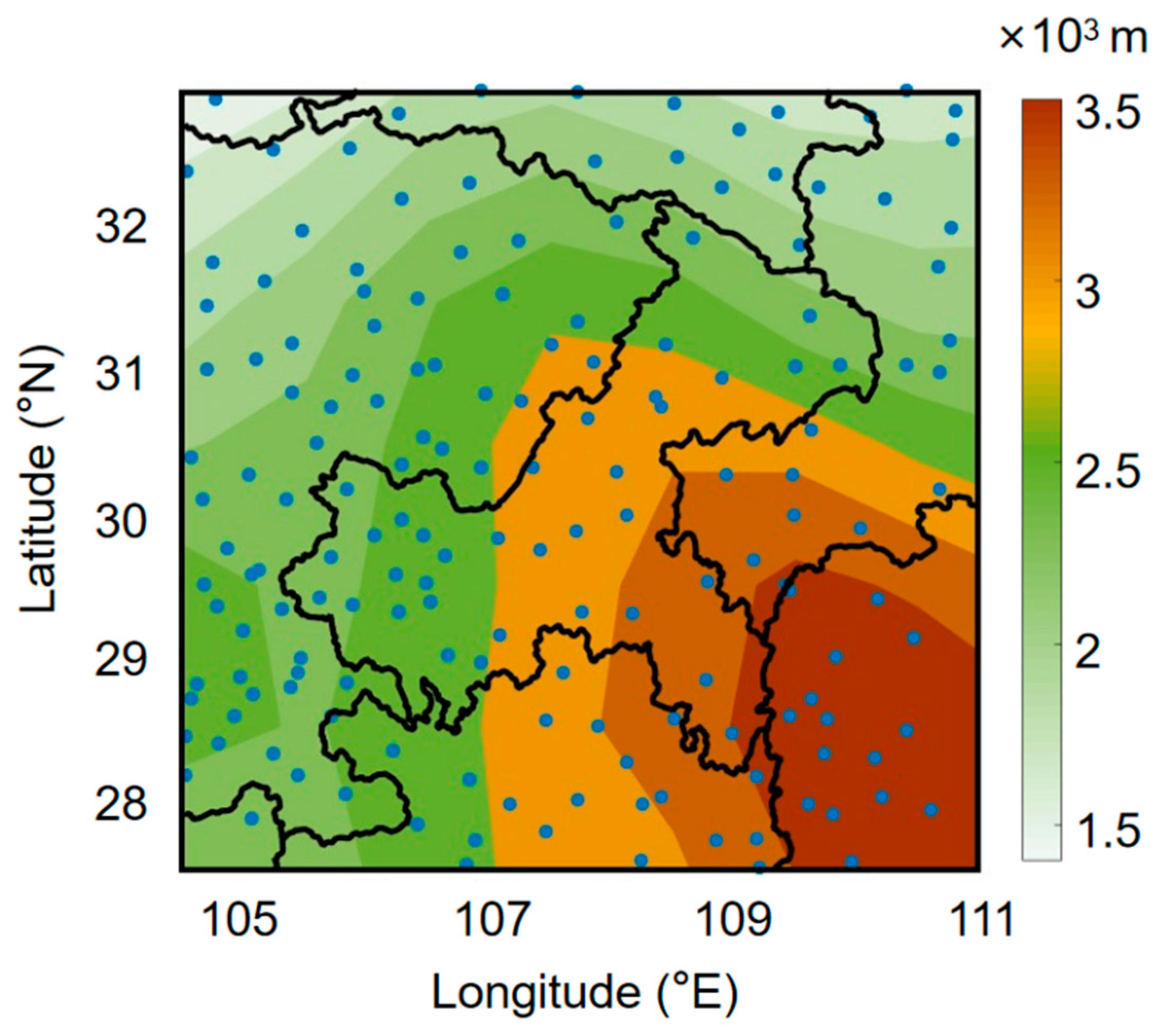
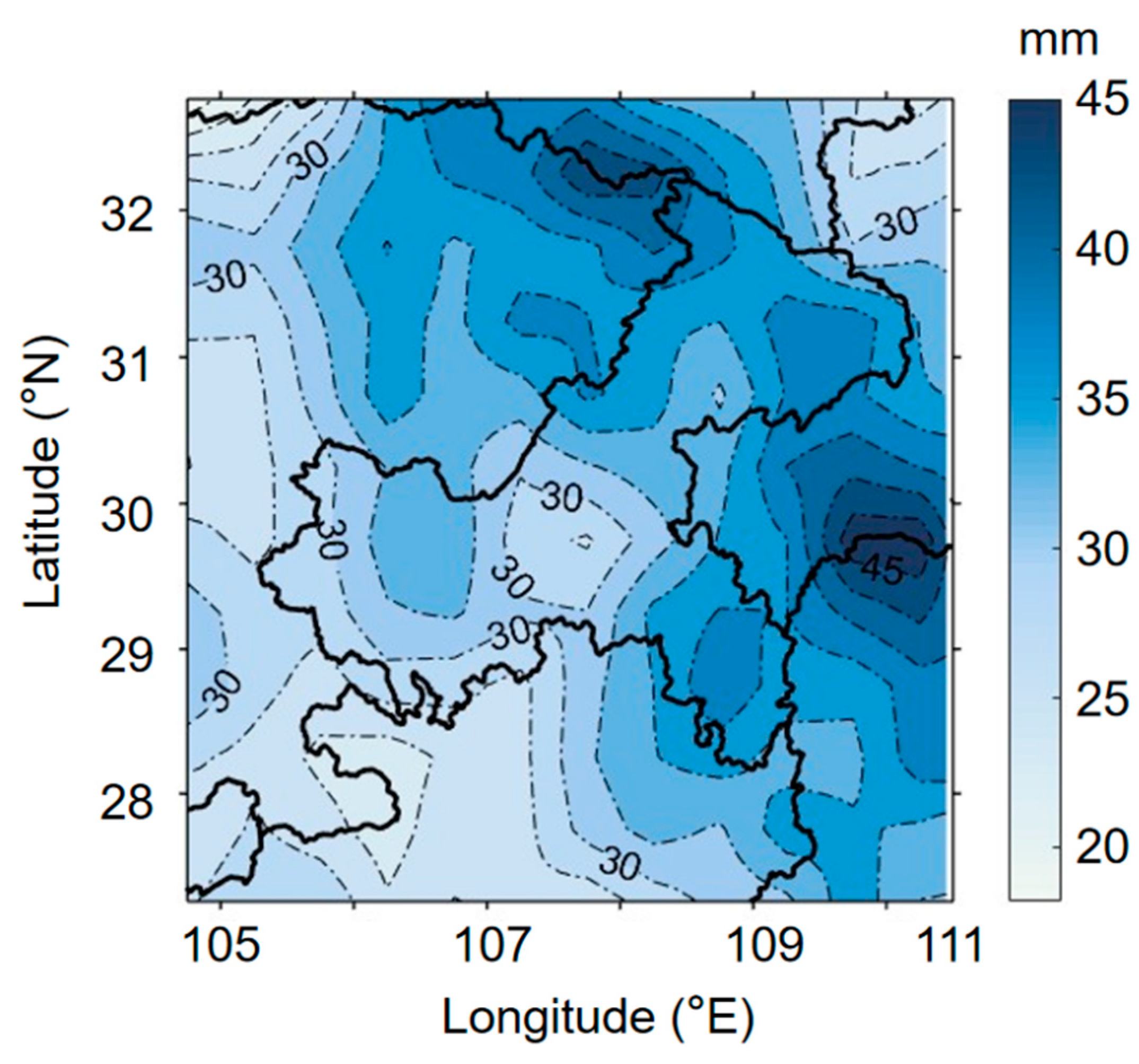
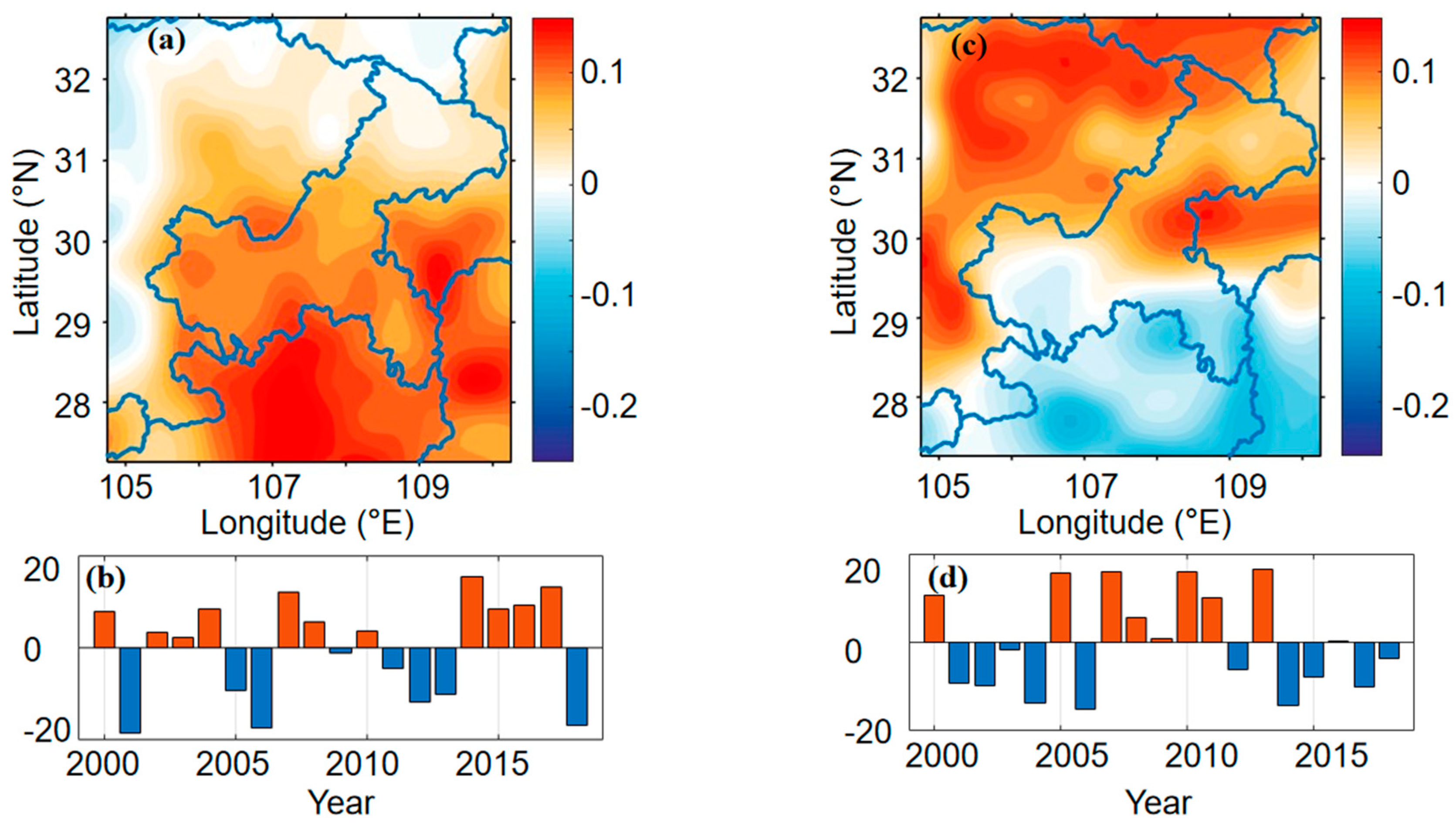

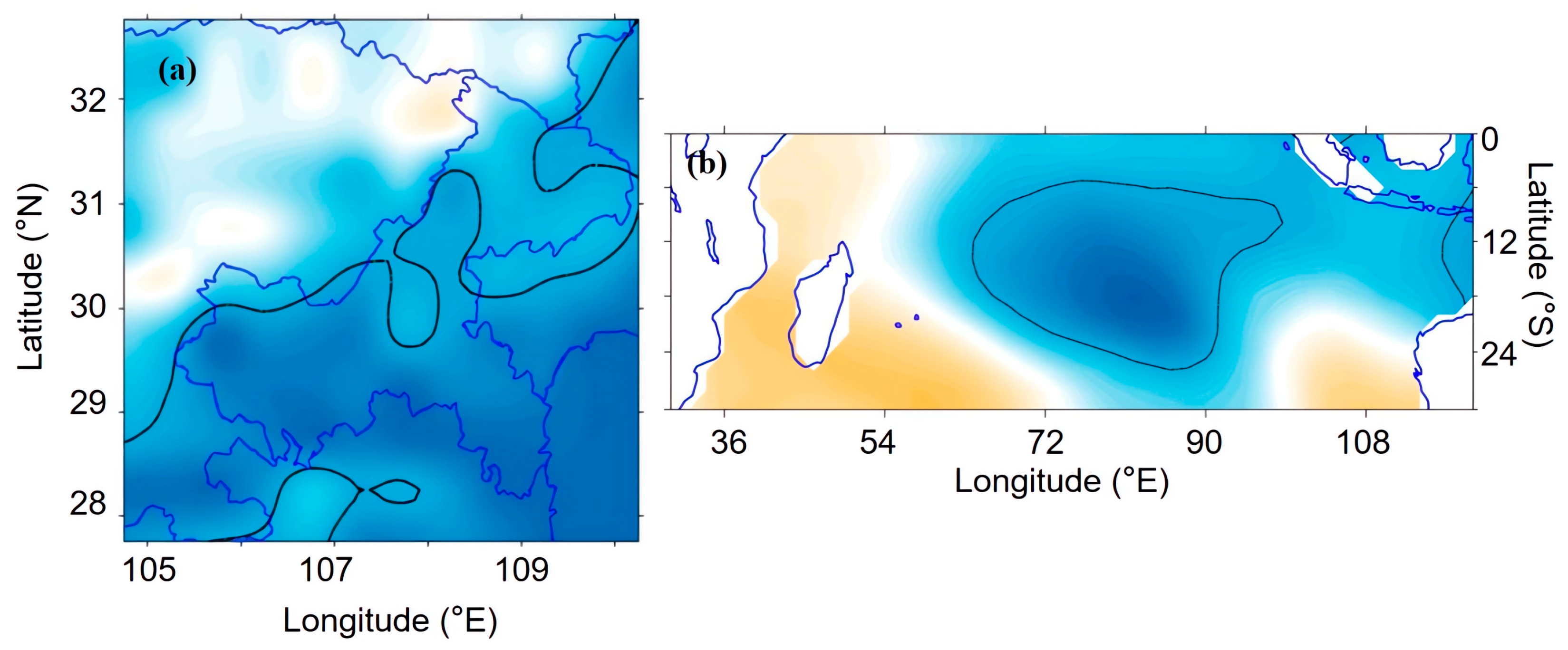
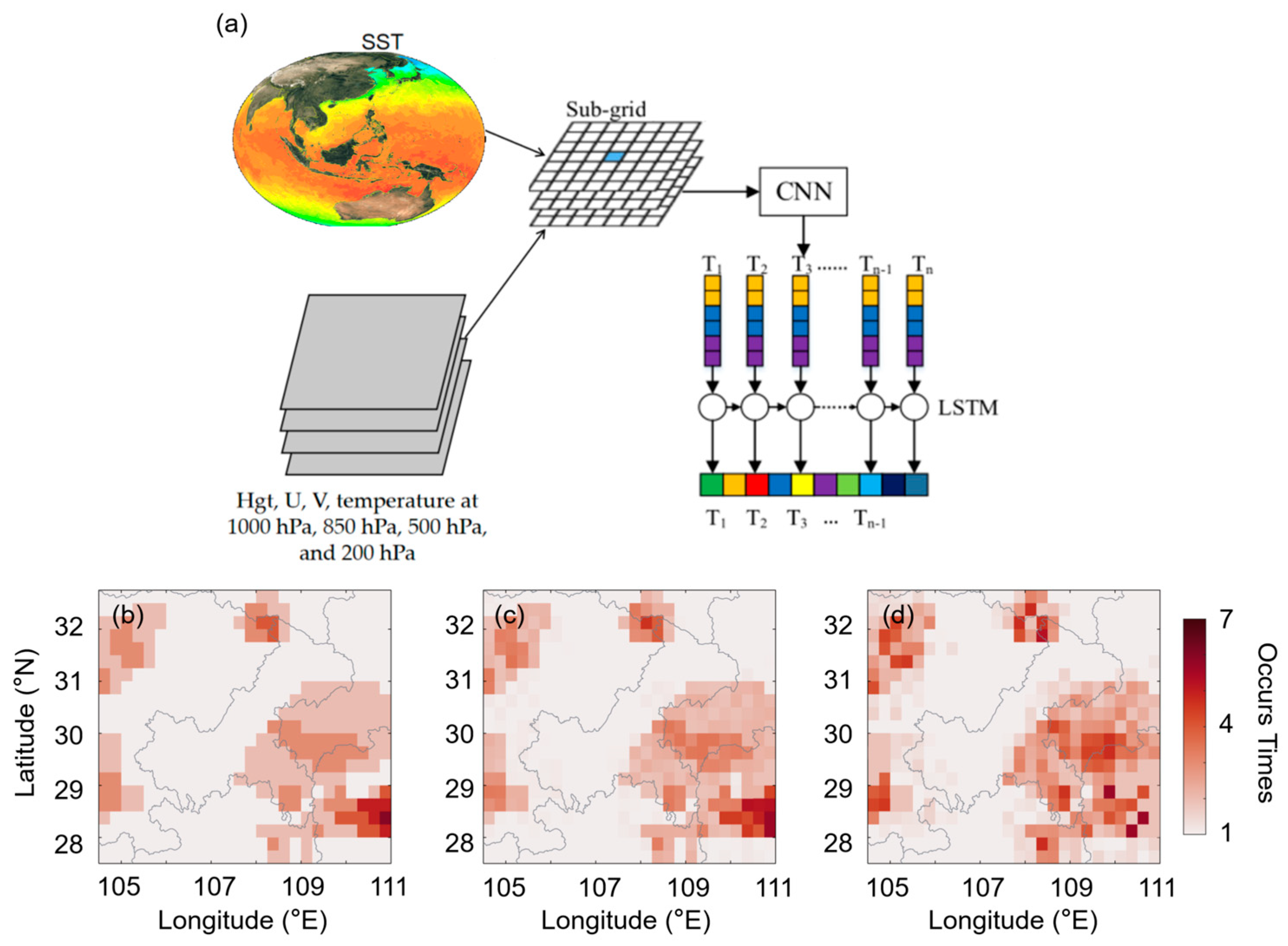
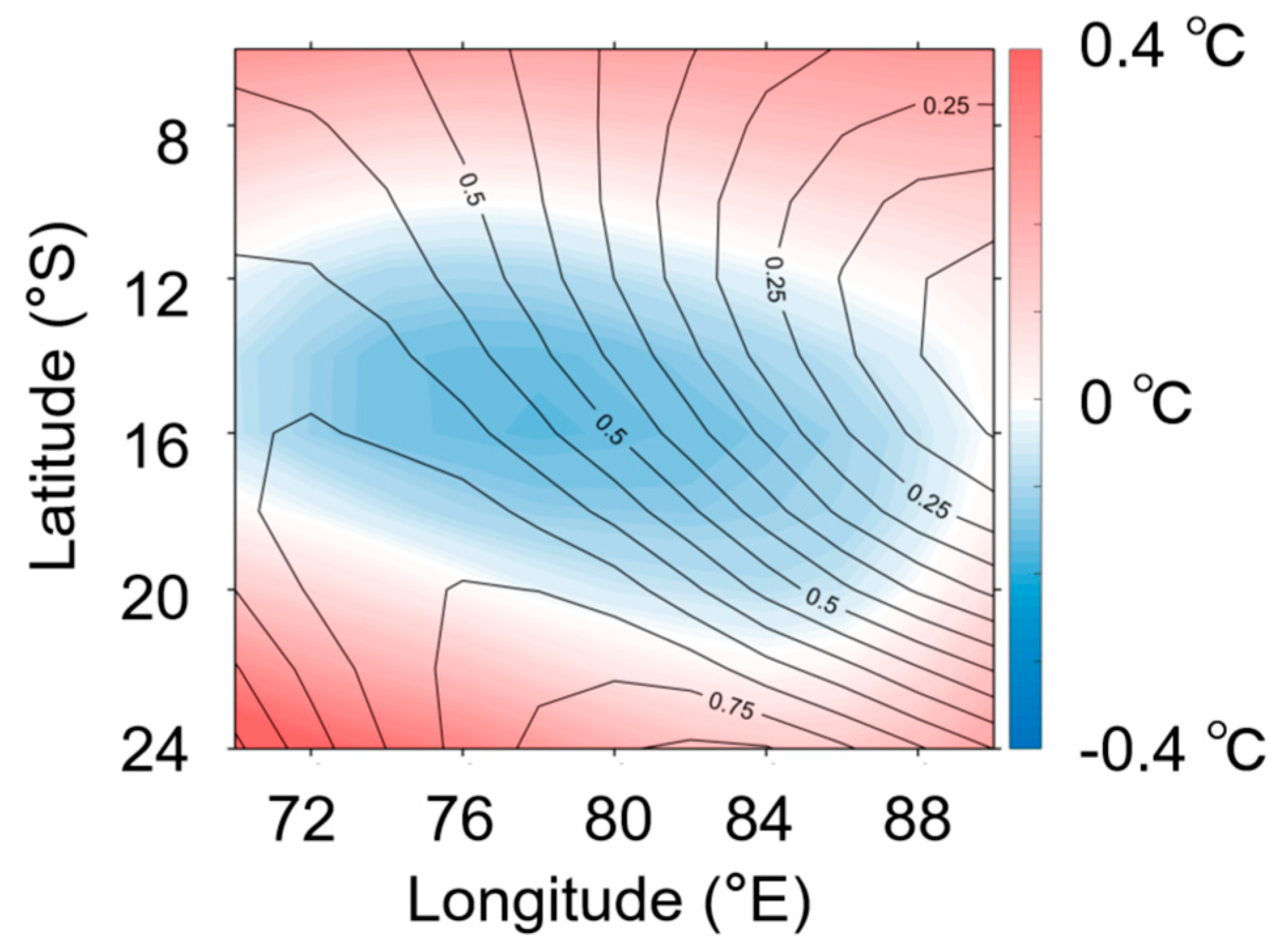
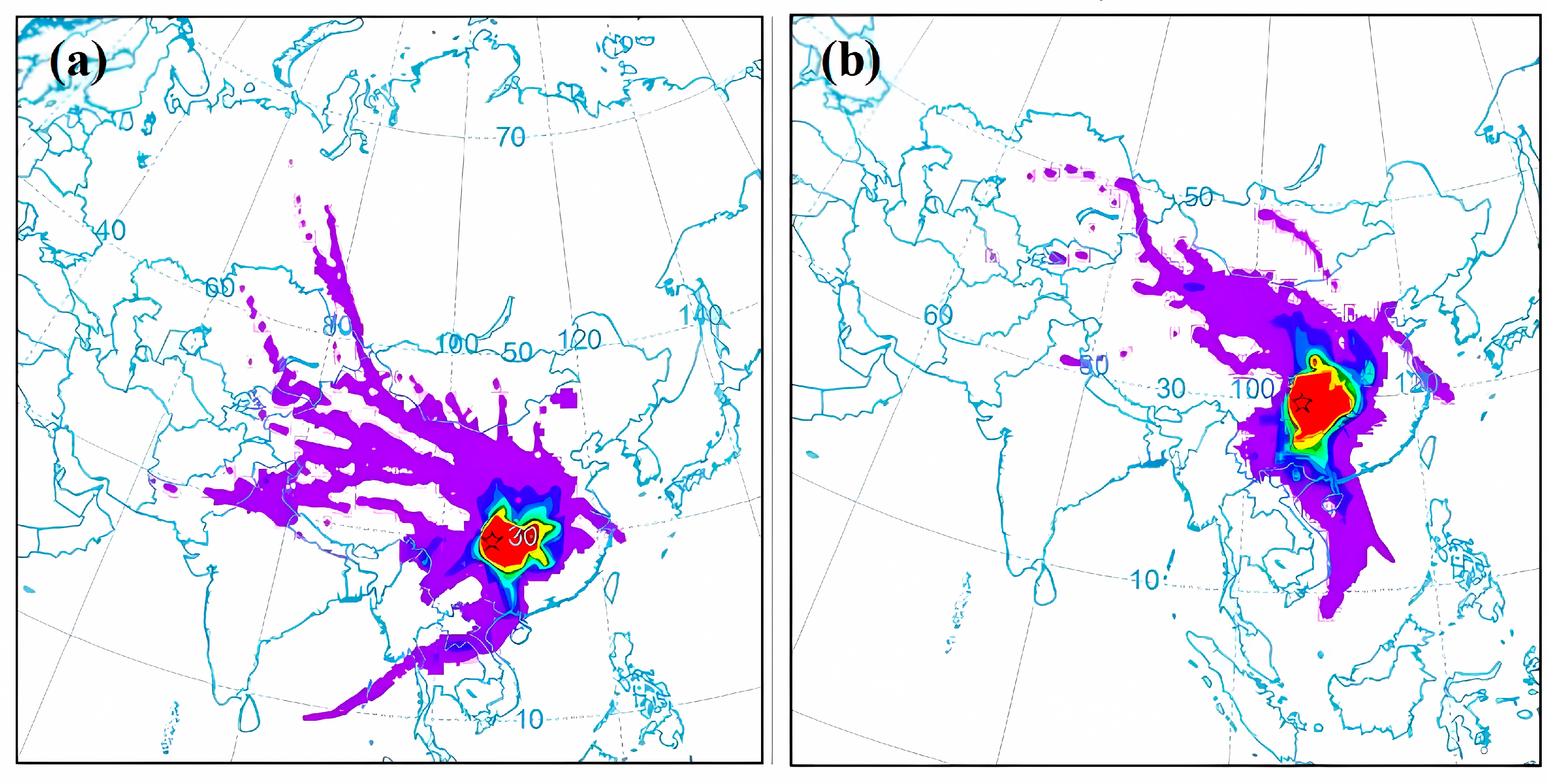

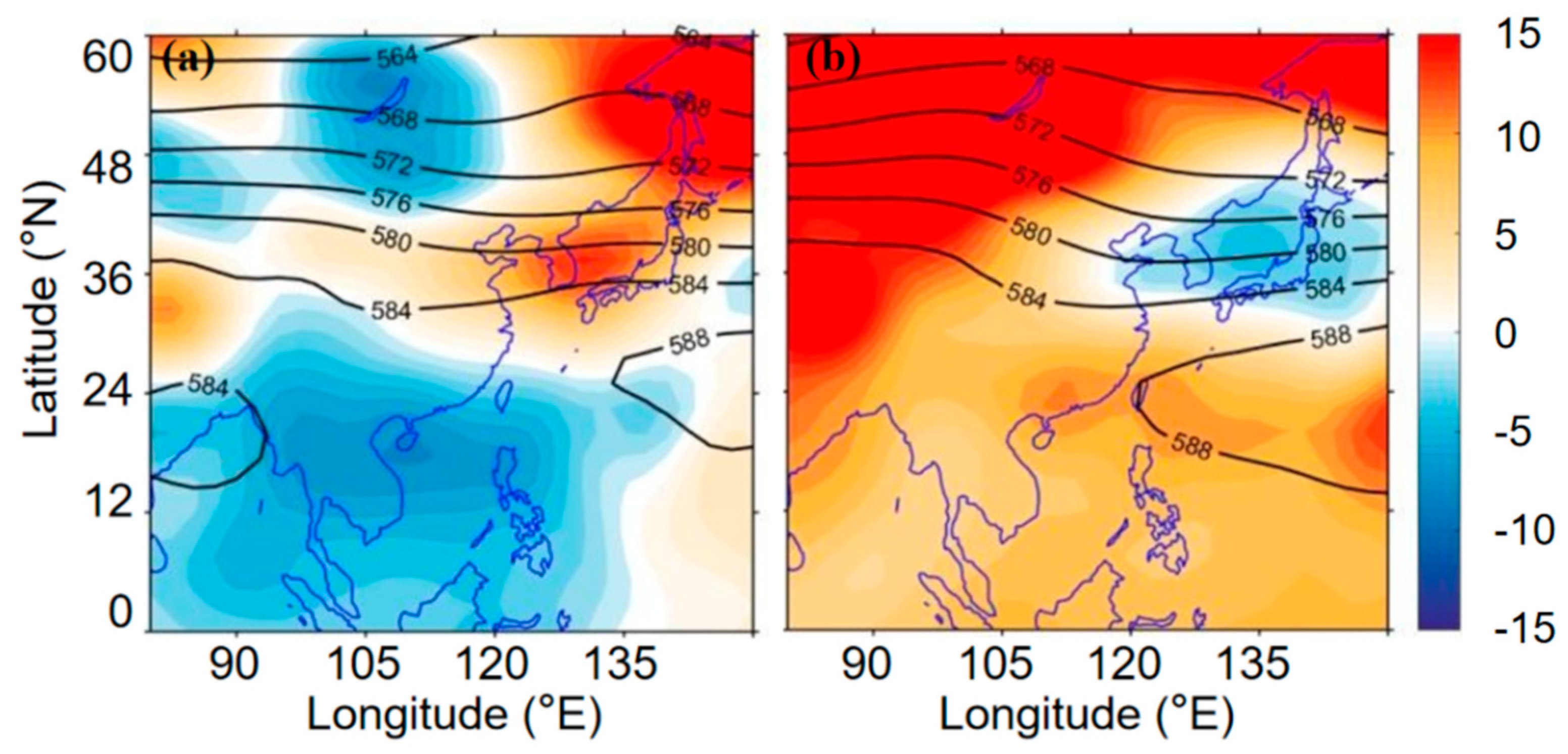
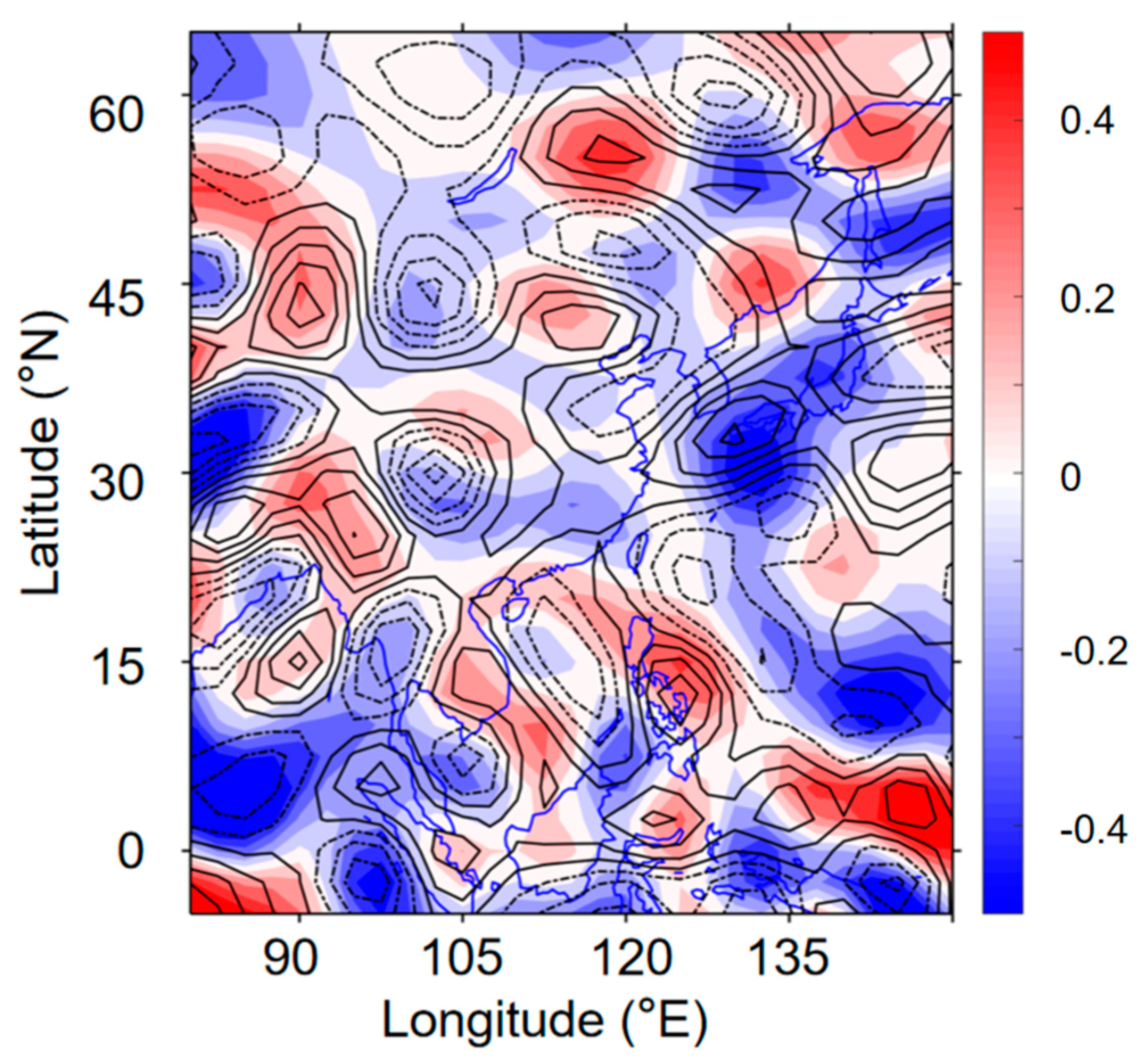

| First Mode | Second Mode | Third Mode | |
|---|---|---|---|
| Variance Contribution | 40.12% | 21.83% | 8.49% |
| Accumulated | - | 61.95% | 70.44% |
| June | July | August | |
|---|---|---|---|
| Correlation Coefficient | 0.5362 | 0.4887 | 0.4170 |
| SIG value | 0.0001 | 0.0003 | 0.0026 |
| Features | June (RMSE/R2) | July (RMSE/R2) | August (RMSE/R2) | Summer (RMSE/R2) |
|---|---|---|---|---|
| No SST | 0.32/0.75 | 0.33/0.71 | 0.39/0.71 | 0.35/0.73 |
| SST | 0.11/0.85 | 0.06/0.89 | 0.07/0.86 | 0.09/0.85 |
| Philippine Sea | South China Sea | Bay of Bengal | |
|---|---|---|---|
| Vertical Movement | 0.06 | 0.41 | 0.10 |
Disclaimer/Publisher’s Note: The statements, opinions and data contained in all publications are solely those of the individual author(s) and contributor(s) and not of MDPI and/or the editor(s). MDPI and/or the editor(s) disclaim responsibility for any injury to people or property resulting from any ideas, methods, instructions or products referred to in the content. |
© 2024 by the authors. Licensee MDPI, Basel, Switzerland. This article is an open access article distributed under the terms and conditions of the Creative Commons Attribution (CC BY) license (https://creativecommons.org/licenses/by/4.0/).
Share and Cite
Lei, S.; Yu, S.; Sun, J.; Wang, Z.; Liao, Y. A Methodology for the Prediction of Extreme Precipitation in Complex Terrains: A Case Study of Central Southwest China. Water 2024, 16, 427. https://doi.org/10.3390/w16030427
Lei S, Yu S, Sun J, Wang Z, Liao Y. A Methodology for the Prediction of Extreme Precipitation in Complex Terrains: A Case Study of Central Southwest China. Water. 2024; 16(3):427. https://doi.org/10.3390/w16030427
Chicago/Turabian StyleLei, Shiyun, Shujie Yu, Jilin Sun, Zhixuan Wang, and Yanzhen Liao. 2024. "A Methodology for the Prediction of Extreme Precipitation in Complex Terrains: A Case Study of Central Southwest China" Water 16, no. 3: 427. https://doi.org/10.3390/w16030427
APA StyleLei, S., Yu, S., Sun, J., Wang, Z., & Liao, Y. (2024). A Methodology for the Prediction of Extreme Precipitation in Complex Terrains: A Case Study of Central Southwest China. Water, 16(3), 427. https://doi.org/10.3390/w16030427






